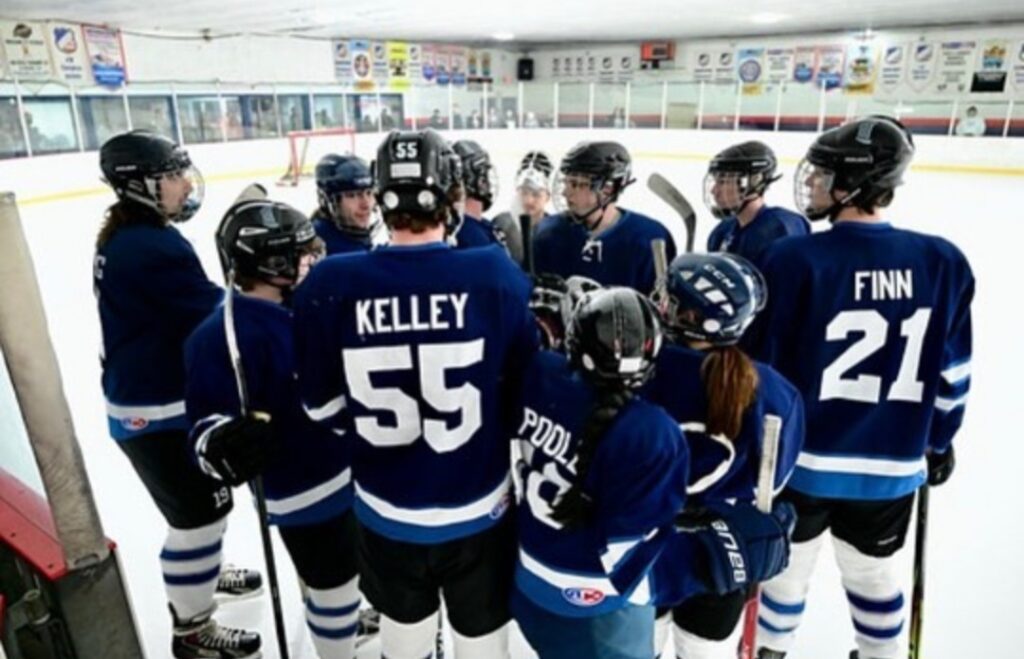Guarding the game: Ice hockey organizations should mandate neck guards to prioritize player safety
4 min read
The UMW ice hockey club gathers on the ice.
Margaret Jackson Opinion Editor
On Oct. 28, 2023, Adam Johnson—an American ice hockey forward for the Nottingham Panthers—passed away at the Utilita Arena Sheffield during a game against the Sheffield Steelers, according to CBS News. During a pile-up, Johnson suffered a fatal cut to his neck from skater Matt Petgrave, and his passing has shed light on the use of safety equipment in sports, specifically neck guards in hockey.
According to CNN, neck guards are not mandatory for hockey players to wear, but in light of this incident, they should be a standard piece of hockey uniforms like gloves and helmets.
Neck guards provide a crucial layer of padding and protection to a player’s neck that is left exposed to skate blades and other players. Because of this, requiring neck guards in both collegiate and professional hockey is a crucial safety measure that needs to be implemented to prevent severe injuries and potential fatalities from taking place.
By mandating neck guards, we can prioritize athlete safety and reduce the risk of life-threatening incidents, such as Johnson’s.
UMW alumna and former ice hockey coach Molly Walsh believes that neck guards should be required—to some extent.
“I think, to some extent, no part of the body should be unguarded or unprotected,” she said. “I’m not saying we play in gerbil balls—if that makes sense—but we also don’t want to take away from the sport and the way you play the sport.”
Sophomore history major Jacob Hardman, who plays center and is the assistant captain for the UMW ice hockey team, does not think that neck guards should be mandatory.
“I don’t think that neck guards should be required,” he said. “I think that players should be able to feel comfortable when they play and that they can choose what they wear. For me, I used to wear a neck guard growing up, and after the incident, I feel that players should be more careful … it has opened a new side of thinking about the game of hockey.”
Other sports, such as Formula One, have implemented additional safety equipment in an effort to protect athletes and improve safety.
According to ESPN, in 2018 the Fédération Internationale de l’Automobile—the governing body for motor sports—mandated that every formula racing vehicle be equipped with a halo device. The device functions as a shield that deflects the impact force in crashes, and it has been credited with saving the life of Romain Grosjean in a crash as well as preventing life-threatening injuries to other drivers.
Similarly, the implementation of neck guards would provide an added layer of safety in hockey—a contact sport—and prevent potential fatalities from occurring.
In response to Johnson’s tragic death, the English Ice Hockey Association and Canadian Hockey Leagues have decided to mandate neck guards, which is expected to take effect this year. However, the ice hockey league that Johnson was playing for at the time of his death—Elite Ice Hockey League—has no plans to implement a neck guard mandate for its players.
According to NPR, The United States Hockey League, the National Collegiate Athletics Association and the National Hockey League don’t require players to wear neck guards; however, it is recommended and currently being discussed.
Meanwhile, some players have taken the decision of whether or not to wear a neck guard into their own hands. According to the website Gino Hard, professional hockey players such as Jake Walman, T.J. Oshie, Tyler Bertuzzi and Rasmus Dahlin—all of whom play for different teams—were seen wearing neck guards on the ice following Johnson’s death.
Hardman, who is the acting vice president for UMW’s ice hockey team, described what equipment he wears for protection on the ice.
“I wear an undershirt that is cut-resistant because of the things that have happened in the past, and I have witnessed players and friends get cut on the arm or the legs from skates,” he said. “Players can wear what makes them feel safe and comfortable. There is no judgment there because if they choose to wear a neck guard or a protective layer then that is up to them and in hockey we try to put safety at the front.”
About increasing safety standards in athletics, senior elementary education major Libby York—who plays prop and hooker for UMW women’s rugby— said, “I think player safety should always be the top priority of any athletic organization. Generally speaking, I think that injury tracking and injury prevention plans could be implemented on a larger scale.”
By requiring players to wear neck guards during gameplay and in practice, the hockey community can reduce the chance of severe injury and even fatalities. In doing so, they would ensure that athletes can enjoy the game while also prioritizing their health and safety.
Furthermore, the idea of protecting athletes extends beyond mandating certain equipment.
“There is no way to completely avoid injury in sports, but it is the responsibility of athletic organizations to track injuries to ensure that they are properly addressed before allowing a player to return to play and implementing training and ‘pre-hab’ that limits the likelihood of common injuries based on the specific sport,” said York.
At the end of the day, it’s not just a matter of maintaining regulations but also about ensuring the health and security of athletes of all ages on the ice. Mandating neck guards is a vital step towards promoting player safety, and allowing athletes to continue playing the game with this additional equipment will hopefully lower the risk of injury in the future.


